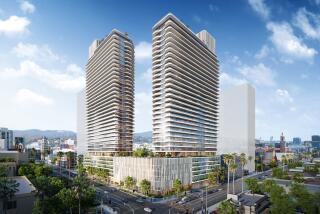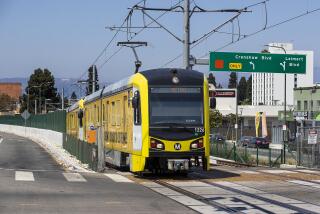End of the Line Proves a New Beginning for NoHo
- Share via
A decade ago, North Hollywood was struggling.
One of the oldest districts in the San Fernando Valley, the area had gained such a reputation for crime and blight that some well-heeled neighborhoods on the edges of North Hollywood actually got the city to change their names. Then the Northridge earthquake left dozens of aging storefronts in the business district destroyed.
Today, North Hollywood is very much on the rise -- and many credit the revitalization to the Red Line. North Hollywood is the northern terminus for Los Angeles’ only subway, which is the centerpiece of a massive redevelopment effort that has changed the face of the community and the rest of the Valley.
North Hollywood is now the closest thing the Valley has to a true urban core, linking mass transit with a thriving arts district that includes more than 20 live theaters as well as bookstores, art galleries and funky shops along Lankershim Boulevard.
More than $500 million in private and public investment is altering the very landscape of the area, with mid-rise apartments and office towers going up. Work is about to begin on a 15-story residential tower and a $200-million loft and retail complex known as NoHo Commons.
With the Orange Line busway set to begin operation through the floor of the south Valley on Saturday, Los Angeles city officials and urban planners see North Hollywood’s turnaround as instructive. The Orange Line runs from the Red Line station in North Hollywood to Woodland Hills, and officials hope it will eventually produce similar “transit villages” elsewhere in the Valley -- providing denser housing and shopping in an area known for sprawl. It is also increasing the pace of development in North Hollywood, where more than a dozen projects are in the works.
North Hollywood is the most dramatic of the development booms that have occurred along rail stations across Los Angeles. Mixed-use apartment and retail centers have risen along Red Line stations in Hollywood, while Long Beach has used the Blue Line to help revitalize its downtown.
The Orange Line, a 14-mile, $324-million dedicated bus route, is expected to spur higher-density development around some of its 13 stations, which are located at such hubs as Warner Center and Valley College.
“The whole idea behind transit-oriented development is to get as many people in walking distance of a transit line as possible,” said Robert Scott, director of the Mulholland Institute, a Valley public policy center. “At some point, there will ... be a move to increase densities among various stations along the line.”
*
North Hollywood was developed more than a century ago when the San Fernando Valley was mostly farmland and open space. In its heyday, it was something of a downtown for the Valley, with shops, banks and hotels lining its main streets and a Red Car trolley line. Like many downtowns, North Hollywood’s business district began to fade after World War II with the rise of shopping malls.
For nearly a quarter-century, the city’s Community Redevelopment Agency sought ways to revitalize the area without much success. Then the 1994 Northridge quake hit, leaving some of the older commercial buildings damaged and vacant.
But around that time, community leaders were beginning an effort to turn the area into an arts district, taking advantage of North Hollywood’s proximity to major studios to lure independent live theaters to the area. In 2000, the MTA opened the Red Line subway station at the once-dormant corner of Lankershim and Chandler boulevards. The line runs from downtown Los Angeles through Hollywood to the North Hollywood station.
Hoping to create a transit village with housing for residents who use the line, the city helped finance numerous apartment and retail projects around the subway station. Since 1999, the Community Redevelopment Agency has spent $80 million in North Hollywood.
But officials say the investment is paying off: For the first time, some private developers are beginning to finance their own projects in the district.
“When developers start coming into an area and don’t start asking for money, that’s a good sign,” said Margarita de Escontrias, regional administrator of the North Hollywood Redevelopment Project.
One of those builders is JSM Construction of North Hollywood and Santa Monica, which is erecting four apartment complexes, including the 15-story tower, which would be one of the Valley’s tallest residential buildings. It’s scheduled to be completed next year.
The $43-million tower will have 17,000 square feet of retail, restaurants and other businesses on the ground floor to encourage walking and street activity. Condominiums with mountain and valley views will be built on the upper levels.
“It’s all about walking across the street [from the subway station] to retail,” said Allen Freeman, development associate for JSM. “It’s giving them an urban-type lifestyle.”
At least 11 other residential developments are also under construction nearby. Today, North Hollywood is a neighborhood in transition, with a mix of new buildings such as the Academy of Television Arts & Sciences, restored historic structures such as the El Portal Theatre and many remnants of the old working-class district of auto shops, discount stores and fast-food restaurants.
Massage therapist Jacqui Everett, who moved into the neighborhood two years ago, likes North Hollywood because it has a pedestrian urban feel without the crowds and noise of the big city. She enjoys hanging out at the coffeehouses and window shopping at the vintage clothing stores and art galleries. But she’s concerned about overdevelopment.
“When it’s all finished, it’s going to be a mess. You already can’t find a place to park,” she said. Like many residents, she likes having the Red Line station nearby but drives almost everywhere.
*
With the building boom in full swing, some fear mom-and-pop stores and financially struggling live-theater operators will be priced out of the neighborhood. Ed Gaynes, president of the Valley Theater League and artistic director of the Whitmore-Lindley Theatre, likened the situation to what happened on Melrose Avenue in Hollywood when that street was transformed into an upscale shopping promenade in the 1980s.
Most of the smaller theater companies that rented space on Melrose were forced to move or shut down, he said.
“If they tear down block after block with all these new high-rises, it’s only a matter of time,” Gaynes said. “But even if they manage to survive increased rents, they’ll be looking for new homes in a few years anyway, because developers are buying everything in sight. It’s starting to get tough.”
Community leaders insist there is room for both new development and existing businesses. But they are also pleased at the new interest North Hollywood is receiving from upscale retailers.
Eric Reuveni, a commercial real estate agent, said he was tickled when he brought executives from How’s Market to the neighborhood.
“They didn’t have a high perception of the area, but I asked them to come out,” said Reuveni, chairman of the neighborhood council’s planning, land-use, housing and transportation committee. “I took them on a walking tour of the area to show them what’s happening. Now they’re going to open a store here.”
More to Read
Sign up for Essential California
The most important California stories and recommendations in your inbox every morning.
You may occasionally receive promotional content from the Los Angeles Times.













